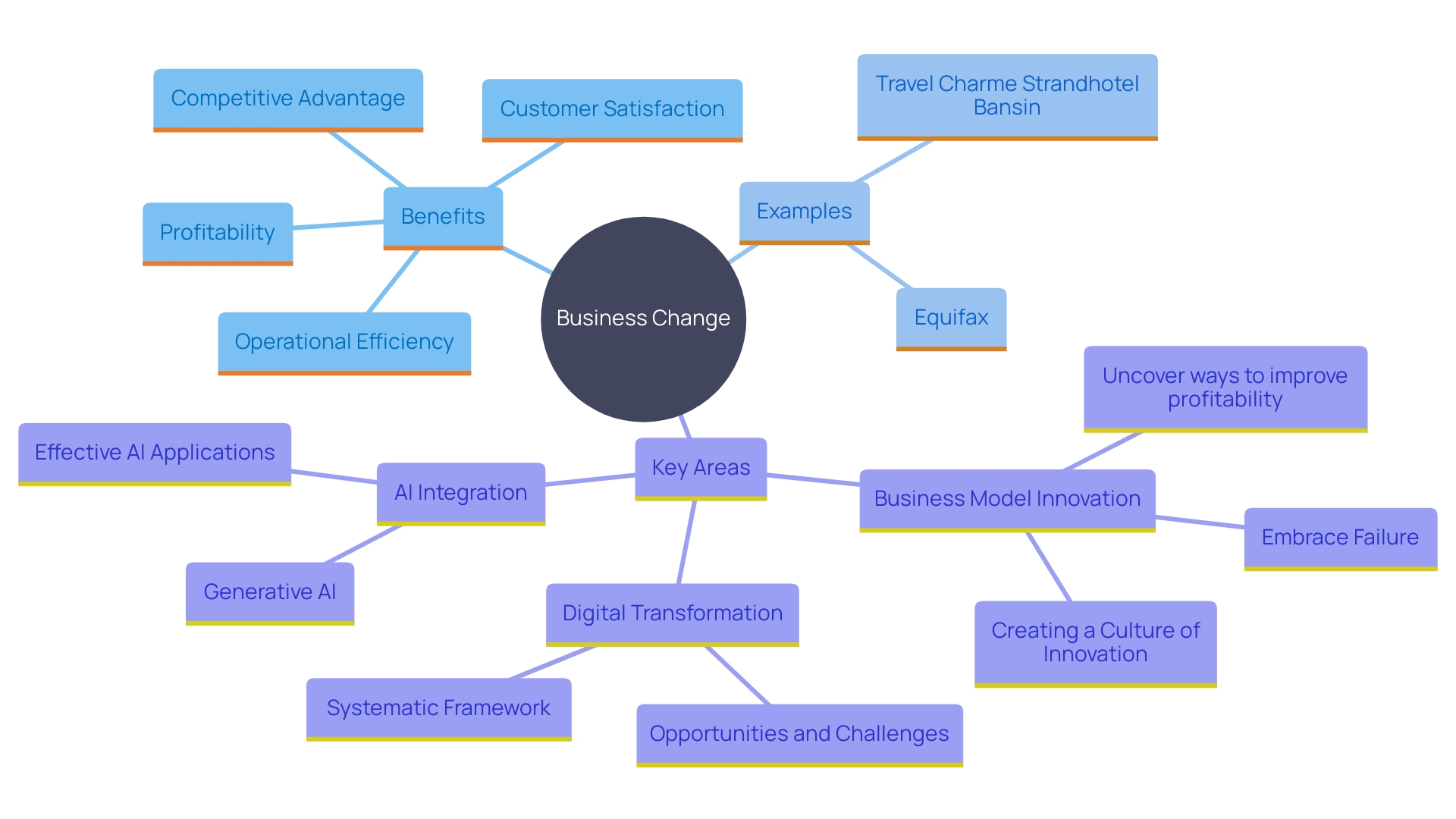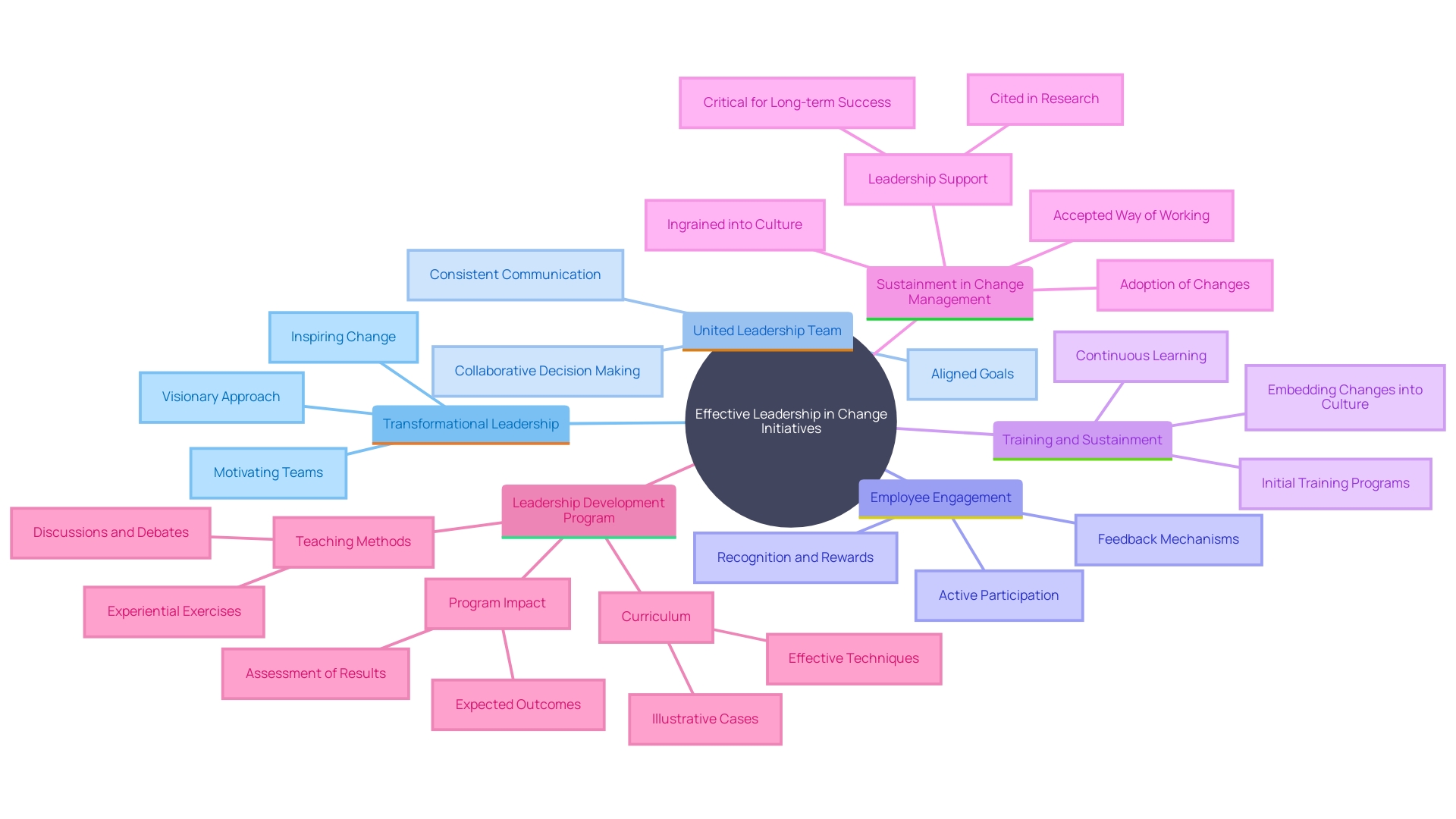Introduction
In an era where market dynamics constantly evolve, business transformation stands as a cornerstone for organizations striving to enhance efficiency, stimulate growth, and maintain a competitive edge. This comprehensive guide explores the multifaceted benefits of business transformation, highlighting how it can streamline operations, reduce costs, and foster innovation for sustained growth. Real-world examples, such as the operational overhaul at Travel Charme Strandhotel Bansin and Equifax's data architecture revamp, illustrate the tangible impacts of technology-driven transformation on efficiency and customer satisfaction.
Moreover, the article delves into the critical elements of successful transformation, emphasizing the necessity of a well-articulated vision, strong leadership, and strategic resource allocation. The role of leadership is further examined, showcasing how transformational leaders inspire and motivate their teams to embrace change and achieve organizational goals. Finally, the importance of measuring success and continuous improvement is discussed, underscoring the need for innovative metrics and a culture of adaptability to ensure long-term success in a rapidly changing business landscape.
Benefits of Business Transformation
'Business change is crucial for organizations aiming to improve efficiency, drive growth, and adapt to evolving market dynamics.'. Key benefits include enhanced operational efficiency, increased profitability, improved customer satisfaction, and a stronger competitive position. Successful change initiatives streamline processes, reduce costs, and foster innovation, leading to sustainable growth.
For instance, at Travel Charme Strandhotel Bansin, the implementation of a streamlined operational model significantly enhanced efficiency. By integrating technology into their operations, they were able to handle peak demand seamlessly, thus improving overall guest satisfaction. This case exemplifies how technology-driven change can enhance operational efficiency and customer satisfaction concurrently.
Moreover, a balanced portfolio approach is essential. While focusing on efficiency is crucial, it should not overshadow growth initiatives. This integrated strategy ensures that organizations do not lose customers to competitors while maintaining sustainable cost levels.
Real-world instances, such as the change at Equifax, emphasize the significance of aligning technology investments with organizational objectives. By creating a comprehensive data architecture, Equifax significantly improved data integration and accessibility, providing deeper insights and enhancing decision-making processes.
According to PwC research, organizations that continuously evolve their business, operating, and technology models capture a performance premium worth more than 13 times that of their peers. This highlights the essential requirement for a comprehensive method to change, incorporating innovation at every stage to create a strong competitive edge.
'Ultimately, high-achieving organizations frequently demonstrate a dedication to organization-wide change, actively utilizing resources to enhance performance.'. These entities are defined by strategic foresight, an emphasis on performance-enhancing activities, and a proactive approach to change. By embracing such practices, entities can place themselves for sustained achievement in a swiftly evolving commercial environment.

Key Elements of Successful Business Transformation
Successful business change relies on several critical elements, starting with a well-articulated vision and strategy. Strong leadership commitment is indispensable, as it sets the tone for the entire organization. Engaging stakeholders early and consistently ensures that everyone is aligned with the transformation goals. A comprehensive roadmap that includes both financial and non-financial KPIs is essential for tracking progress and identifying potential issues.
Organizations must begin by assessing their current state to identify areas for improvement. This involves deploying talent where it is needed most and ensuring that top performers are allocated to high-value initiatives. The importance of data cannot be overstated; using real-time data and AI can provide insights into which areas of the company are most affected and what actions are best to maximize investments.
Effective communication and change management practices are vital. Leaders who steer their groups through these stages are far more likely to succeed. As stated by Professor Scott Snell, who possesses considerable expertise in strategic management, a definitive playbook and frameworks for action are essential for fostering sustainable change.
Governance and structure also play a significant role. Companies should define the role of the Chief Transformation Officer (CTO) and establish clear decision rights. Furthermore, comprehending the Change Capability Quotient can assist leaders in assessing the organization's preparedness for change.
Ultimately, the financial results of a successful change can be significant, provided there is collaboration and clear communication. Avoiding traps such as lack of collaboration, poor communication, and data integrity issues is essential for achieving cost reduction and top-line growth. With these components established, entities can maneuver through the intricacies of change and attain lasting success.
The Role of Leadership in Business Transformation
Guidance is essential in directing entities through change initiatives. Leaders must convey a compelling vision and motivate their teams to embrace change. Effective leadership encompasses nurturing a culture of innovation and accountability, enabling employees to actively participate in the change process. This commitment requires investment in training and development to ensure the workforce is equipped with the necessary skills and knowledge to adapt to new challenges.
Transformational leadership, a concept introduced by James MacGregor Burns, emphasizes inspiring and motivating people to reach their highest potential. This leadership style is not merely about directing but also about encouraging intellectual stimulation and individualized consideration. By challenging followers to think critically and solve problems creatively, transformational leaders drive significant change within the entity.
A united leadership team mindset is vital for successful business change. This alignment starts from the CEO and extends to the entire leadership team, fostering an environment of effective communication, engagement, and collaboration. Leaders need to build a coalition and empower individuals to act in ways that help achieve the group's vision.
Statistics highlight the importance of leadership in transformation. In top-quartile organizations, 11% of employees own initiatives or milestones, a figure 2.6 times higher than in bottom-quartile organizations. Furthermore, 41% of survey participants recognize competitive pressure as the main catalyst for change, and 79.7% of organizations must adjust every two to five years to thrive in a swiftly transforming market.
Real-world examples underscore the significance of sustainment in change management. Ensuring that changes become ingrained in the organizational culture is essential for long-term success. Leaders must stay involved in sustainment efforts even as they shift focus to new strategies, as experience and data indicate that premature disengagement can weaken change initiatives.

Measuring Success and Continuous Improvement
To assess the efficacy of organizational change efforts, companies must create clear and innovative metrics and performance indicators. Regularly evaluating progress against these benchmarks allows for timely adjustments and reinforces a culture of continuous improvement. Successful companies are increasingly leveraging advanced technologies, such as AI, to redefine performance metrics and challenge long-held assumptions about business success drivers. This shift enables real-time transparency into ongoing activities and resource allocation.
Moreover, it's essential to integrate innovation at the heart of transformation efforts rather than treating it as a separate entity. This integration promotes creativity, adaptability, and forward-thinking, helping organizations build a powerful competitive advantage. Companies should focus on a balanced approach, ensuring neither efficiency nor growth is neglected, thus avoiding unsustainable costs or losing customers to competitors.
Feedback from employees and customers is crucial for identifying areas for further enhancement. Methods such as Net Promoter Score (NPS) surveys, data analytics, and user behavior analysis are effective in gathering this feedback. This guarantees that change initiatives stay in harmony with organizational objectives and market requirements. In our survey of agile companies, those that attained the highest technology scores showed that modern tech systems and platform operating models greatly aid in successful changes. These companies also showed a significant impact on revenues, productivity, time to market, cost savings, and customer and employee satisfaction.
Ultimately, organizations need to rethink their metrics to be more customer-focused and aligned with company objectives and key results (OKRs). This involves a candid evaluation of impact metrics, particularly in areas showing scant progress. Honest assessments and clear action plans can drive meaningful change and ensure that the business actively participates in the transformation, working hand in hand with IT and other functions.

Conclusion
Business transformation is not merely a trend; it is a fundamental necessity for organizations aiming to thrive in today’s dynamic market landscape. By embracing transformation, companies can achieve enhanced operational efficiency, increased profitability, and improved customer satisfaction. Real-world examples, such as the successful initiatives at Travel Charme Strandhotel Bansin and Equifax, underscore the tangible benefits of integrating technology and strategic alignment in driving transformation efforts.
An integrated approach that balances efficiency with growth initiatives further solidifies a company’s competitive position.
The success of business transformation hinges on several critical elements, including a clear vision, strong leadership, and effective communication. Leaders play a pivotal role in inspiring their teams and fostering a culture of accountability and innovation. By engaging employees and aligning them with the organization's goals, leaders can enhance the likelihood of successful transformation.
The establishment of a comprehensive roadmap with defined KPIs ensures that organizations can track progress and make necessary adjustments throughout the transformation journey.
Moreover, measuring success and fostering a culture of continuous improvement are essential for sustaining transformation efforts. Organizations need to adopt innovative metrics that reflect their unique objectives and align with customer needs. By leveraging advanced technologies and integrating feedback mechanisms, businesses can remain agile and responsive to market demands.
Ultimately, a commitment to ongoing evaluation and adaptation will empower organizations to navigate the complexities of transformation, ensuring long-term success and resilience in a rapidly evolving business environment.




